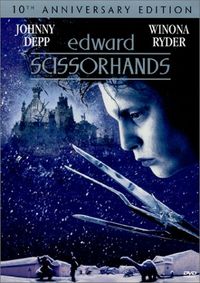Edward Scissorhands
From Wikipedia, the free encyclopedia
Edward Scissorhands is a movie written by Tim Burton and Caroline Thompson. Burton also directed the movie and it was released in 1990. The movie is a fable set in an exaggeratedly stereotypical vision of American suburbia that intentionally combines clichés from both the 1950s and late 1980s. It also has a central theme of the isolated, misunderstood major character, a theme that recurs in much of Burton's work. It stars Johnny Depp and Winona Ryder. Further, many of the motifs and themes of the 1931 film Frankenstein are referenced in Edward Scissorhands.
Contents |
Plot
When the neighborhood Avon lady, Mrs. Peg Boggs (Dianne Wiest) fails to make any profits in her neighborhood, she goes to the creepy castle on the hill and meets Edward (Johnny Depp). Edward is an artificial man whose inventor (Vincent Price) dies before being able to put hands on his creation. Instead Edward has long metal scissor-blades for hands. Mrs. Boggs brings Edward home to her family and thus Edward must adjust to life in the suburbs. He falls in love with Kim Boggs (Winona Ryder), who hates Edward at first, but grows to love him while everybody else in the neighborhood grows to distrust him because of his dangerous handicap. At the end, Edward and Kim go their separate ways, but love remains between them.
Motifs and Themes
The plot of Edward Scissorhands bears resemblances to Mary Shelley's novel, Frankenstein, in as much as Edward is an artificially created man; however, such similarities to the novel are limited.
For example, both Edward and Frankenstein's monster are both "monstrous", and left wanting when it comes to the ability to show love to other beings as a result, yet Edward's Creator adored him and wished to give him all he desired, in contrast to the central themes of Shelley's Frankenstein.
Rather, Edward Scissorhands follows more closely the plot of the 1931 motion picture Frankenstein in that Edward, a creature without malice or knowledge of deception, is naïve to the selfish, malicious, deceitful, and fearful nature of his human hosts (Additionally, Edward's appearance, with black clothing, shambling, almost mechanical gait, and pale, scarred face, resembles that of the Frankenstein monster in the 1954 Hammer Films version of the story). As a result, an innocent mistake by Edward is interpreted as a malicious act by the people of the neighborhood, and leads to his ultimate "destruction" by a crowd of those who Edward had trusted and had thought of as friends, but whose apparent friendship may only ever have been a mask for their underlying fear and misunderstanding of Edward.
Similarities and common plot developments are also seen between Edward Scissorhands and the classic story Beauty and the Beast; in both, a misunderstood and visually frightening (but nonetheless emotionally sensitive) "beast" earns the affection of the lead female character while becoming the object of the townspeople's derision and hatred. From there, it is easy to find a parallel between "Edward Scissorhands" and Andrew Lloyd Webber's musical version of The Phantom of the Opera. Erik the Phantom is a considerably less benign character than Edward; however, the climax of "Edward Scissorhands", in which Kim breaks a scissored implement from one of the scientist's machines and shows it to the lynch mob arrives as proof of Edward's "death", bears a striking resemblance to the final moments of "The Phantom of the Opera", in which the character Meg Giry produces the Phantom's mask when announcing to the assembled mob (and the audience) that the unhappy man is gone forever.
Another story it resembles is an old fairy tale about the Scissorman (here), a sort of Bogeyman with scissors for hands who uses them to cut off the thumbs of children who suck their thumbs.
Edward Scissorhands can also be read as a visual representation of teenage isolation. The "freakish" appearance in terms of clothes, wild hair and visual scarring on the face is a very effective metaphor for a troubled teen in adolescence. The scissorhands themselves could be a visual metaphor for feeling unable to communicate love to those around you. Many have commented that this film represents how Burton (and many) felt during their teenage years.
The film demonstrates an example of mob psychology.
Trivia
Tim Burton describes the movie as a very personal creation. Edward even bears a physical similarity to the director, particularly with regard to his wild hairstyle. Danny Elfman, who composed the film's soundtrack, also refers to his score for Edward Scissorhands as his most personal work.
Tim Burton stated that he named the lead character "Edward" because of its similarity to the name "Ed Wood."
Tom Cruise and Robert Downey Jr. were both seriously considered for the role of the title character.
Johnny Depp would later become a regular in Tim Burton movies, starring as Edward Wood, Jr. in Ed Wood, Ichabod Crane in Sleepy Hollow, Willy Wonka in Charlie and the Chocolate Factory, and Victor Van Dort in Corpse Bride.
Landing the role of Edward in the film held a somewhat ironic stance where Depp was concerned, his first role appearing as a victim in Wes Craven's "A Nightmare on Elm Street," which featured Freddy Krueger, a murderous shapeshifter who killed with a razor-blade fingered glove, eerily paralleling Edward's own hands in the film.
